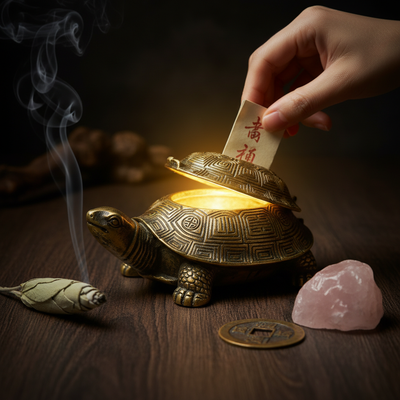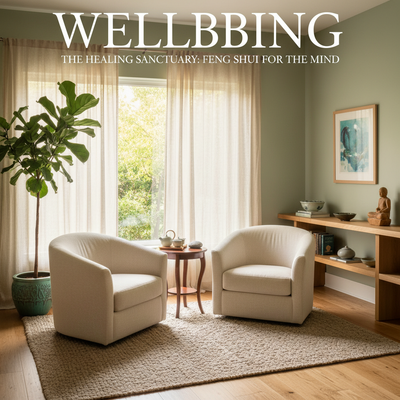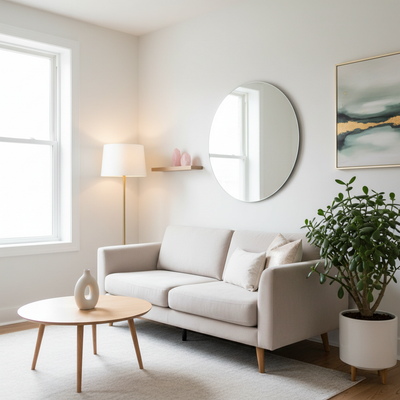Is your bedroom really a place where you can rest well, or does it make you feel stressed? Everyone wants a peaceful, restful space, but it can be hard to create. This guide will show you how to change your bedroom's energy using calm feng shui bedroom colors. In Feng Shui, color is much more than just how things look. It's a powerful way to change the energy, or Qi, in your room. When you understand and use these old ideas, you can create a space that feels deeply peaceful and helps you feel better overall. This guide will help you make a bedroom that doesn't just look nice but feels truly restful.
Understanding Feng Shui Color

To make smart choices, you need to understand why certain colors work well in Feng Shui. This knowledge helps you go beyond simple lists and create a space that truly supports your energy and goals. The ideas are simple, make sense, and come from watching nature.
The Flow of Qi
In Feng Shui, everything is about the quality and flow of Qi (said like "chee"), which is life force energy. The goal for a bedroom is to create slow, nourishing, and yin energy.
- Yin Energy is quiet, dark, soft, and calm. It's the energy of rest, receiving, and healing. Think of a quiet lake at sunset.
- Yang Energy is bright, loud, hard, and active. It's the energy of work, talking, and movement. Think of the bright sun at noon.
Other rooms in your home, like the kitchen or office, work better with more active, yang energy. The bedroom, however, is a yin space. Your color choices are the best tool you have to slow down the Qi and help create this restful feeling.
The Five Elements
The Five Elements, or Wu Xing, are the basic tools for working with color in Feng Shui. They are a way of grouping the different types of Qi. Each element connects to specific colors, energies, qualities, and life goals. Understanding them is important for creating a balanced space.
| Element | Associated Colors | Energy/Feeling |
|---|---|---|
| Water | Blues, Black | Calm, Flow, Wisdom |
| Wood | Greens, Browns | Growth, Healing, Life |
| Earth | Sandy Colors, Light Yellows, Beiges | Stability, Caring, Grounding |
| Metal | Whites, Grays, Pastels | Clarity, Precision, Purity |
| Fire | Reds, Oranges, Bright Purples | Passion, Energy, Action |
Finding Your Balance
The Five Elements work together in different ways. They can support and strengthen each other (the Helpful Cycle) or weaken and control each other (the Challenging Cycle). For a bedroom, we focus on colors that work well together. For example, the Water element (blue) feeds the Wood element (green), making a mix of soft blues and greens a beautiful and supportive choice for a healing feeling. On the other hand, Fire (red) burns Wood, so a bright red and green room could feel conflicted and disturbing. This knowledge helps you choose colors more wisely and effectively.
Top 5 Calm Colors
Here are the best calm feng shui bedroom colors, chosen for their ability to create the most peaceful feeling. Each one connects to a specific element and offers unique mental and energetic benefits.
Soothing Blues
Why it works: Directly connected to the Water element, blue is the perfect color of calm. It makes you think of a peaceful ocean or a wide sky, bringing peace, quiet thinking, and a sense of deep inner wisdom. It slows down energy, making it perfect for a space meant for rest.
Best for: Bedrooms where the main goals are deep, uninterrupted sleep and reducing stress. Blue is excellent for people who have trouble quieting their minds at night. Studies about color and psychology often link shades of blue to real calming effects, including slower heart rates and lower blood pressure.
Shade suggestions: Avoid dark, heavy navy in large amounts. Choose soft powder blue, muted teal, gentle sky blue, or a grayish periwinkle. These shades are restful without feeling cold or sad.
Healing Greens
Why it works: Green represents the Wood element, the energy of growth, life, and renewal. It connects us directly to the healing power of nature. A green bedroom can help you feel refreshed and renewed, as if you've taken a walk in a forest. It supports flexibility and healing on all levels—physical, emotional, and spiritual.
Best for: Creating a space that feels both restful and life-giving. It's an excellent choice for anyone recovering from illness or going through a period of personal growth. It provides calm without feeling stuck, offering a gentle, revitalizing energy.
Shade suggestions: Look to nature for ideas. Sage green, mint green, pale olive, and soft seafoam are all wonderful choices that feel caring and balanced.
Grounding Earth Tones
Why it works: The Earth element provides the energy of stability, support, and care. Think of the feeling of standing barefoot on warm sand. Earth tones create a foundation of security and self-care. These colors are very grounding, helping you feel centered and secure in your space.
Best for: People who often feel scattered, anxious, or ungrounded. If your life feels chaotic, an earthy bedroom can provide a much-needed sense of being held and protected. It is the best color family for creating stability and a sense of belonging.
Shade suggestions: A wide and flexible range includes sandy beige, soft taupe, warm creams, light terracotta, and even a very pale, buttery yellow. These colors create a cozy, surrounding feeling.
Soft Pinks & Peaches
Why it works: While the Fire element is usually too stimulating for a bedroom, its softest forms—pinks and peaches—are an exception. These colors invite gentle warmth, softness, and the energy of love. They are connected to the heart, encouraging self-love, compassion, and harmony in relationships.
Best for: Improving partnership and romance in a couple's bedroom or encouraging self-care and gentleness in a single person's room. These colors create a cozy, caring, and inviting feeling that feels like a warm hug.
Shade suggestions: Choose muted, sophisticated shades to avoid a childish feel. Dusty rose, blush pink, soft peach, and coral-mixed creams are all beautiful and calming options.
Muted Lavender
Why it works: Lavender is a lighter, more yin shade of purple, which is also connected to the Fire element. It carries a high spiritual feeling, often linked to royalty, luxury, and higher consciousness. In its muted form, it can quiet the mind and encourage spiritual calm and thinking.
Best for: A bedroom that also serves as a space for meditation, yoga, or spiritual practice. It's also wonderful for those who want to calm mental chatter and connect with their intuition. It creates a sense of peace that is both relaxing and subtly uplifting.
Shade suggestions: Stick to the soft, grayed-out versions. Muted lavender, soft lilac, and heather tones are ideal. Avoid bright, strong purples, which can be too stimulating.
Create Your Personal Palette
General advice can only help so much. The most powerful Feng Shui is personalized. Follow this step-by-step guide to move beyond the basics and choose the perfect calm feng shui bedroom colors for your unique needs.
Step 1: Define Your Intention
First, get clear on what you want to feel in your bedroom. What is its main purpose for you right now? Your intention is your energetic compass.
- For deep sleep and stress relief, lean into the Water and Earth elements. Your best colors are soft blues, sandy beiges, and warm taupes.
- For healing and renewal, focus on the Wood element. Your ideal colors are sage green, mint, and other nature-inspired greens.
- For romance and partnership, invite the soft Fire and Earth elements. Look to blush pinks, soft peaches, and grounding creams.
- For mental and spiritual calm, a touch of the high-vibration Fire element is perfect. Consider muted lavender and lilac.
Step 2: Consider the Occupants
The energy of the people using the room is an important factor.
- For a Couple's Bedroom: The goal is to support partnership. Earth element colors (beiges, creams) are excellent as they encourage stability and care. Soft pinks and peaches can improve romance. The key is to find a balance that both partners find soothing and attractive. A blend of a neutral earth tone with accents of blue or green can be a harmonious compromise.
- For a Child's Bedroom: Children are constantly growing and developing. Soft greens (Wood element) support their growth, while gentle earth tones (Earth element) can provide a sense of stability and security, which is especially helpful for anxious children. Soft blues can be calming before sleep.
- For a Single Person's Bedroom: This space is all about you. Match the colors with your personal goals. If you're focused on healing from a past relationship, a caring green might be perfect. If you're building self-love, a soft pink or peach is wonderful. If your focus is on stability and career, grounding earth tones provide a solid foundation.
Step 3: Align with the Bagua Map
For a more advanced technique, you can match your color choice with the Bagua map, the energy grid of your home. First, figure out which area of the Bagua your bedroom is located in. You can do this by standing at your front door looking in; the far right corner is Love & Marriage, the middle left is Health & Family, and the front left is Knowledge & Self-Growth. Once you know the area, you can use colors that support that life area's element.
| Bagua Area | Element | Supportive Colors for a Calm Bedroom |
|---|---|---|
| Love & Marriage (Kun) | Earth | Earth tones, soft pinks, warm whites |
| Health & Family (Zhen) | Wood | Greens, light blues (Water feeds Wood) |
| Knowledge (Gen) | Earth | Earth tones, muted blues, soft greens |

Choosing a color that supports both your personal intention and the Bagua area creates a powerful energetic alignment.
Application & Real-World Example
Theory is one thing; practice is another. Here's how to bring these calming colors into your space effectively, plus a real-world example of the transformative power of this work.
Smart Ways to Add Color
You don't have to paint all four walls to shift the energy. In fact, a more layered approach is often more effective.
- Accent Wall: The most impactful wall to paint is the one behind your bed's headboard. This creates a strong, grounding anchor for the room and is the first thing you see when you enter.
- Bedding & Linens: This is one of the easiest, lowest-commitment ways to introduce a new color. A soft blue duvet or earthy beige sheets can instantly change the feel of the room.
- Artwork & Decor: Choose art that not only features your desired colors but also creates a feeling of calm. A peaceful landscape or a calming abstract piece works well.
- Rugs & Curtains: Large fabric elements have a big impact on the room's energy. A soft green rug or creamy white curtains can define the color story.
- The 60-30-10 Rule: Use this classic design principle for a balanced look. Your main color (e.g., a soft beige wall) should take up about 60% of the space, a secondary color (e.g., a green duvet and curtains) about 30%, and an accent color (e.g., soft pink pillows) about 10%.
Case Study: A Client's Sleep Solution
To show how this works in practice, we want to share a recent client story. It shows how a targeted change in calm feng shui bedroom colors can deeply impact well-being.
-
The Challenge: Our team at THE QI FLOW was approached by a client, a young professional in a high-stress finance job, who was suffering from chronic insomnia and anxiety. She described her nights as "wired and tired." Her bedroom was painted a stark, cold white (a harsh expression of the Metal element) with cool-toned LED lighting. The energy felt sterile, clinical, and completely un-restful, mirroring the stress of her workday.
-
The Feng Shui Solution: During our consultation, we identified the client's primary need for grounding, caring, and calming energy to counteract her hectic lifestyle. We recommended a multi-layered approach. The primary color was shifted from the stark white to a warm, sandy beige (Earth element) on three walls to create an immediate sense of stability and warmth. For the accent wall behind her bed, we chose a deep, muted teal (Water element) to encourage deep calm and peace. We advised her to replace her cool lighting with warm, dimmable bulbs and to layer textures with a soft wool rug and linen bedding in creamy off-whites.
-
The Transformation: The result was amazing. Within weeks of the changes, the client reported a big improvement in her ability to fall asleep and stay asleep. She described the feeling of entering her bedroom as "a full-body exhale." The room was transformed from a source of stress into a true sanctuary. This case study is a powerful example of how a strategic and intentional approach to color can be a life-changing act of self-care.
Colors to Use with Caution
While the focus is on what to use, it's equally important to know what to avoid in a bedroom setting.
- Bright Reds & Oranges: These strong Fire element colors are highly stimulating and active (yang). They can increase heart rate and lead to restlessness, agitation, or even arguments.
- Large Amounts of Black: While black is a Water element color, using it in large quantities on walls can feel heavy, oppressive, and may lead to feelings of depression or sadness. Use it sparingly as a grounding accent.
- Bright, Stark White: This is a strong Metal element color. While clean, it can feel sterile, harsh, and clinical, especially with cool lighting. It reflects too much light and energy, which is not good for deep relaxation. Choose softer, warmer off-whites instead.
Your Journey to Rest Begins
Creating a peaceful bedroom is one of the most important investments you can make in your health and happiness. You now have the basic knowledge to move forward with confidence. You understand the power of Qi, the language of the Five Elements, and the importance of choosing calm feng shui bedroom colors with clear intention. Whether you start small with new bedding or begin a full room transformation, remember that this process is an empowering act of self-care. Your journey to a truly restful, restorative sanctuary begins now.








0 comments